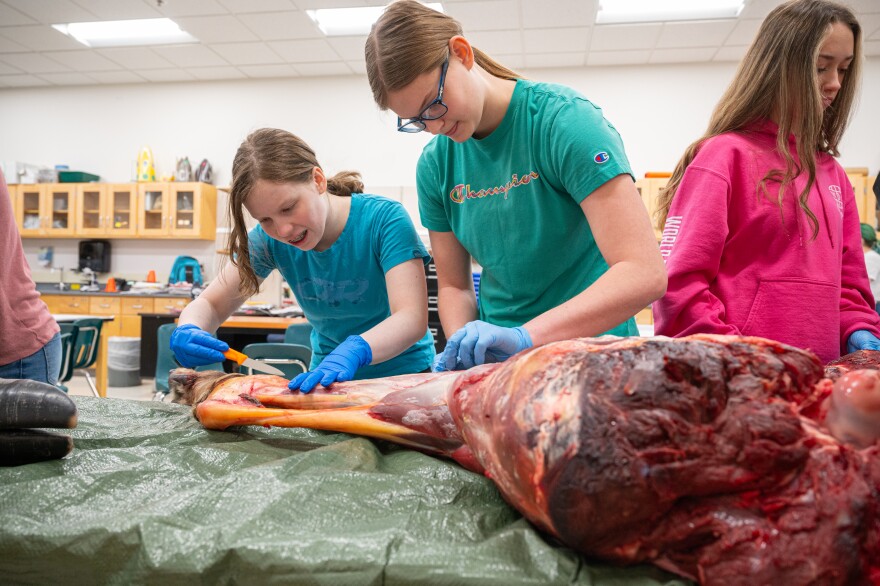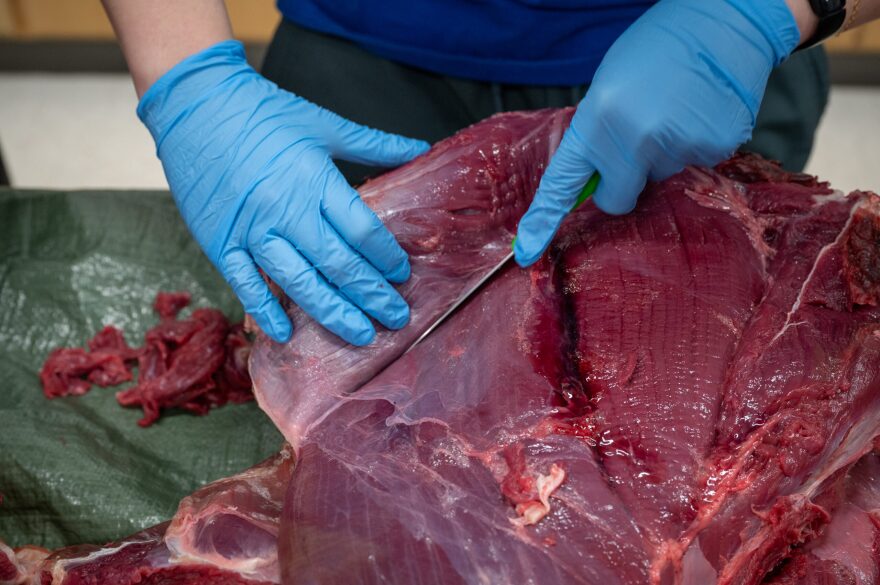A Chugiak High School classroom played host to a moose this month, and though it entered intact, the ungulate left in pieces.
The bull moose was the star of a lesson plan featuring instruction on butchering and processing game animals, and the significance behind those activities.
Not every freshman biology class is as viscerally rooted in Alaska culture, but their teacher, Brian Mason, had harvested the animal with an education permit. The number of these special hunting permits issued by the Alaska Department of Fish and Game quadrupled this year.
Mason grew up in Eagle River hunting, fishing and berrypicking with his family. But many students in his class, even at the northern edge of the Municipality of Anchorage, haven’t had those experiences.
The class spent a couple days skinning, quartering and deboning the animal before trimming and grinding the meat into hamburger.
“It’s incredibly rewarding, first of all, just seeing the engagement of the students,” Mason said. “You know, on a day-to-day basis I’d like to think that my students are generally engaged in regular lessons, but the level of engagement is through the roof for this.”
Before the students even began skinning the moose, they heard from Indigenous Alaskans. That included Evon Peter from Arctic Village, an Indigenous studies professor at the University of Alaska Fairbanks, who told them about his cultural traditions when harvesting a moose.
“The best way to learn how to do something is to put your hands on it and to gain the experience, the experiential knowledge, so I told them not to be scared or be shy,” Peter said. “I think there’s real deep life lessons related to understanding that, as human beings, we’re part of nature and we’re interconnected with it and dependent on it.”
That resonated for 14-year-old student Jeremiah Haas.
“The most important thing for doing this is respecting the animal because it gave its life for us,” Haas said. “That way we can enjoy it and give it to people who don’t really have access to that much food.”
Haas and the other students in Mason’s class spent most of a recent morning trimming meat away from one of the hind quarters.
“I was very excited for this, because the closest thing I’ve ever had to hunting was just dipnetting with fish. I’ve never actually gone moose hunting before, so taking this apart is actually kind of cool,” Haas said.
Eventually, the moose was neatly broken down into 244 individual packages weighing about 400 pounds total. Students also took home one package each, and the rest was donated to families in the community.
Haas and the rest of his classmates are taking biology and a class called Alaska Studies concurrently.
It allows for a unique blend of lessons, from anatomy to cultural practices, which included conversations with elders, who told the students about how they honor harvested animals and share the meat with their entire village, Mason said.
”So this is an opportunity to kind of combine those sometimes disparate worlds into a single lesson,” he said.
This is the third time Mason has harvested a moose on a cultural education permit, though the first time he’d brought an entire moose into the classroom. He shot the bull, which had antlers spanning 52 inches, near Big Lake on Dec. 3.
The Alaska Department of Fish and Game began issuing educational permits in 1995. They allow for the harvest of nine different types of game animals, according to Alaska Administrative Code, “for the teaching and preservation of historic or traditional Alaskan cultural practices, knowledge, and values.”
Ryan Scott, acting director of the state Division of Wildlife Conservation, said the permits are primarily aimed at creating educational opportunities, not necessarily to provide students or their families with game meat.
“To actually have the ability to put your hands on an animal while you're processing it just reinforces that knowledge and that connection, much more than just being talked at in a lecture setting or something like that,” Scott said.
And there is apparently growing interest in the cultural education hunting permits.
Last year, the division says, it only issued 10 of them. In 2023, that number exploded to 41. The permits are most popular on the Kenai Peninsula but have also been issued in the Northeast Arctic, Interior and in Southwest Alaska.
The Chugiak High moose was popular on social media, too.
Before the students’ work was done, a video from earlier in the week showing the lifeless animal getting rolled into the school had more than 8,000 shares and 800 comments on Facebook.
Mason, the teacher, said most of the commenters were voicing their support for the class project.
“There were a lot of people that said something along the lines of, ‘Finally the teachers are teaching worthwhile things,’ or, ‘Finally they're doing something great in schools,’” he said. “And the reality is there is so much good happening in our public schools every day in every classroom.”




